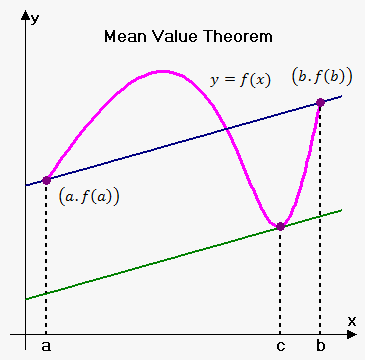Mean Value Theorem
Mean Value Theorem (Lagrange Theorem). Suppose that function $$$y={f{{\left({x}\right)}}}$$$ is defined and continuous on closed interval $$${\left[{a},{b}\right]}$$$ and exists finite derivative $$${f{'}}{\left({x}\right)}$$$ on interval $$${\left({a},{b}\right)}$$$. Then there exists a point $$$c$$$ $$$\left({a}<{c}<{b}\right)$$$ such that $$$\frac{{{f{{\left({b}\right)}}}-{f{{\left({a}\right)}}}}}{{{b}-{a}}}={f{'}}{\left({c}\right)}$$$.
 Note, that there can be more than one such point.
Note, that there can be more than one such point.
Recall that $$$\frac{{{f{{\left({b}\right)}}}-{f{{\left({a}\right)}}}}}{{{b}-{a}}}$$$ is slope of line through points $$${\left({a},{f{{\left({a}\right)}}}\right)}$$$ and $$${\left({b},{f{{\left({b}\right)}}}\right)}$$$.
So, a geometrical interpretation of the Mean Value Theorem is following: there exists such number $$$c$$$ between $$$a$$$ and $$$b$$$ that tangent line at this point is parallel to the line that passes through points $$${\left({a},{f{{\left({a}\right)}}}\right)}$$$ and $$${\left({b},{f{{\left({b}\right)}}}\right)}$$$.
Example. If an object moves in a straight line with position function $$$s={f{{\left({t}\right)}}}$$$, then the average velocity between $$$a$$$ and $$$b$$$ is $$$\frac{{{f{{\left({b}\right)}}}-{f{{\left({a}\right)}}}}}{{{b}-{a}}}$$$ and the velocity at $$$t=c$$$ is $$${f{'}}{\left({c}\right)}$$$. Thus, the Mean Value Theorem tells us that at some time $$${t}={c}$$$ between $$${a}$$$ and $$${b}$$$ the instantaneous velocity is equal to that average velocity. For instance, if a car traveled 200 km in 2 hours, then the speedometer must have showed $$${100}\frac{{{k}{m}}}{{h}}$$$ at least once.
